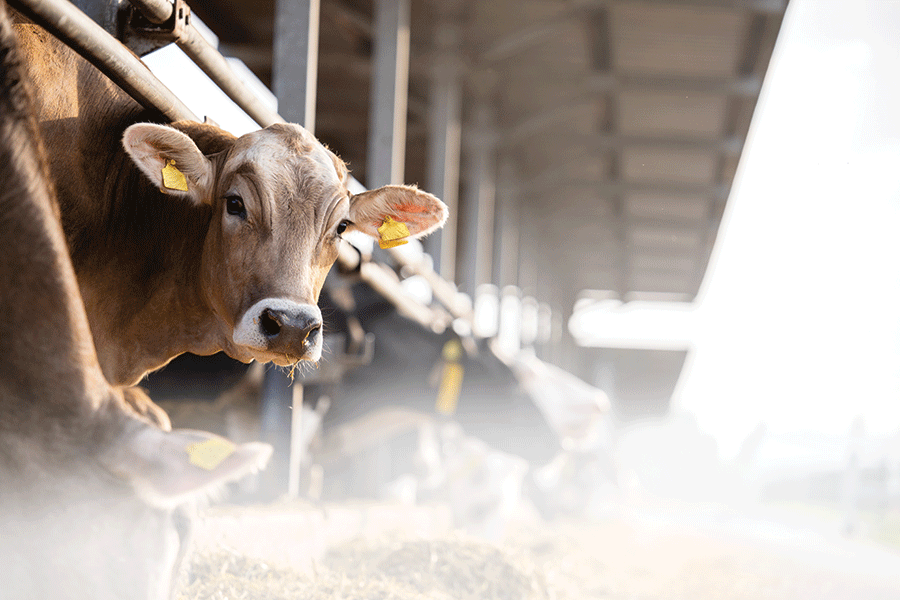Dilemma in the Dairy
Research links spread of highly pathogenic avian influenza with cattle milking.
Story by Joe Montgomery

Over the last two years, highly pathogenic avian influenza, also known as H5N1, has been decimating populations of wild birds — first in Europe and later in the United States. As of spring 2024, H5N1 was unexpectedly detected in cattle in the United States and has, to date, affected more than 200 dairy cattle farms in 14 states. The connection between birds and cattle was not immediately apparent, but research in the College of Veterinary Medicine has shown a surprising reason for the spread of this disease among dairy cattle: the act of milking.
“Milking equipment and anthropogenic activities were suspected to be involved in the transmission of H5N1, but clear evidence of the mode of transmission had been lacking,” says Dr. Jürgen Richt, who is a Regents distinguished professor, University Distinguished Professor in Diagnostic Medicine and Pathobiology, Kansas Bioscience Authority eminent scholar in the College of Veterinary Medicine and member of the National Academy of Medicine. He published his findings in the paper "H5N1 clade 2.3.4.4b dynamics in experimentally infected calves and cows," which was published Sept. 25, 2024 in the journal Nature.
In a collaborative effort, research teams led by Drs. Richt and Martin Beer from the Friedrich Loeffler Institute in Germany experimentally infected both calves and lactating cows with H5N1 clade 2.3.4.4b virus, the strain of the virus circulating in cattle in the U.S., to gain insight into likely modes of transmission. They compared susceptibility and transmission in nine calves infected by oral and nasal inoculation and three lactating cows via inoculation of the mammary gland. In addition, the mammary glands of three other dairy cows were inoculated with H5N1 euDG, the avian influenza clade 2.3.4.4b strain that is circulating in Europe.
Pinpointing the means of transmission
Infection of the calves resulted in mild clinical disease, with moderate viral replication and no transmission to co-housed calves. In contrast, the dairy cows developed severe mammary gland infection, characterized by fever, mastitis and abrupt reduction in milk yield. Drastic increases in the levels of virus in the milk were observed, but there was no evidence of systemic infection or nasal shedding of the virus. These findings indicate that the milk and milking procedures, rather than respiratory spread, are the likely primary routes of H5N1 transmission between cattle.
"There are nearly 10 million dairy cows in the United States today. It is imperative that we study the ways this new disease transmits in dairy cows," Dr. Richt says. "Given the potential economic damage to the cattle industry and risk to human health presented by bovine H5N1, this research shows that establishing safe, sanitary milking procedures is a topic of substantial concern within the U.S. dairy industry."
"Dr. Richt's ability to orchestrate an international collaboration to provide answers regarding viral transmission within months of new disease recognition is extraordinary," says Dr. Bonnie Rush, Hodes Family Dean of the veterinary college. "Similar to COVID-19, this Nature publication is a shining example of the expertise of this research team to rapidly pivot resources and deliver relevant data in response to an emerging zoonotic disease." This study was funded in part by the State of Kansas National Bio and Agro-Defense Facility Transition Fund, and the animal research was conducted at K-State's Biosecurity Research Institute and the Friedrich-Loeffler-Institut in Germany.
Further findings
Having discovered the method of transmission, Dr. Richt’s team and collaborators have also been looking at other aspects of HPAI transmission. Because Dr. Richt’s Center for Emerging and Zoonotic Infectious Diseases specializes in this type of research and because of his access to the Biosecurity Research Institute, K-State is the premier institution to handle the investigations of these types of outbreaks.
“It’s important to note that we have established a team that can do this type of research,” Dr. Richt says. ”We are well trained and we know how to handle all the aspects that are involved in a high-containment research environment.”
Dr. Richt’s team has been prolific and moved quickly to publish findings in connection with HPAI. In September 2024, the team published “Bovine Highly Pathogenic Avian Influenza Virus Stability and Inactivation in the Milk Byproduct Lactose,” which looked at two methods to inactivate the virus. A key finding involved the persistence of the HPAI virus in lactose byproducts that are used in animal feed products.
In October of the same year, the team published “Detection and characterization of H5N1 HPAIV in environmental samples from a dairy farm,” which emphasizes the critical need for better epidemiological monitoring of zoonotic diseases.
Dr. Richt says the research is not just limited to cows.
“We have done experiments in pigs just to see how this virus works in pigs,” Dr. Richt says. “It's good news for the swine industry. There’s not much happening with this virus, but we still need to be vigilant. There’s incredible environmental contamination with this strain right now. If we don’t prevent it from spreading now, then perhaps in a decade — maybe two, three or four decades — it could become a plague.”
Prestigious Professor
The CVM’s Dr. Jürgen Richt has received one of the highest honors in the fields of health and medicine. In October, he was elected as a member of the National Academy of Medicine.
As a Kansas Regents Distinguished Professor, a University Distinguished Professor in diagnostic medicine and pathobiology, and a Kansas Bioscience Authority eminent scholar in the College of Veterinary Medicine, Dr. Richt is among 90 regular members and 10 international members who were elected this year to the academy. Collectively, the National Academy of Medicine provides policymakers, professionals, business leaders and the public with independent, scientifically informed analysis and recommendations on issues related to health and the biomedical sciences.
New academy members are selected each year from a list of nominees. Members are chosen based on their professional qualifications and accomplishments as shown through their publications and research grants.
Dr. Richt was elected for "being a pioneer in infectious diseases of 'One Health' importance." According to the academy announcement, his prolific basic and translational research findings on emerging pathogens of livestock, wildlife and humans are unique and highly significant for animal and public health, and his biocontainment expertise is crucial for the nation's bio- and agro-terrorism defense capacities.
"We are incredibly proud of Dr. Richt for this remarkable accomplishment," said Dr. Hans Coetzee, interim vice president for research at Kansas State University. "Being selected to join the National Academy of Medicine is a testament to his outstanding contributions to the field and his dedication to advancing medical science and improving healthcare.
